The difference between class and id in CSS: Purpose: class is used for general feature styling, and id is used for unique element identification. Selection method: use dot symbol (.) for class and hash symbol (#) for id. Scope of application: class can be applied to multiple elements, and id can only be used for one element. Priority: id is higher than class, id style overrides class style. Best practice: use lowercase hyphens in class names and uppercase underscores in id names.

The difference between class and id in CSS
The class and id in CSS are both used for selection and style Two basic selectors for HTML elements. The main differences between them are as follows:
1. Purpose
- class:is used to classify elements based on their common characteristics Styling, such as colors, fonts, etc.
- id:is used to identify a unique HTML element that only appears once in a page.
2. Selection method
- class:Use the dot symbol (.) followed by the class name to select elements, such as
.class-name.
- id:Use the hash symbol (#) followed by the ID name to select elements, such as
#id-name.
3. Application scope
- #class:can be applied to multiple elements, indicating that they have the same characteristics.
- id:Can only be applied to one element to ensure it is unique on the page.
4. Priority
- id:has a higher priority than class, which means using id The selected style will override the style selected using class.
- class:The priority is lower than id, but can be used in combination to achieve more complex effects.
5. Best Practices
- Class name:should use lowercase letters and hyphens, such as
page-header.
- ID Name:should use uppercase letters and underscores, such as
MAIN_HEADER.
- Selector selection:Prefer using the id selector to identify unique elements, and use the class selector to style elements with common characteristics.
- Uniqueness of ids:Avoid using duplicate id names in pages as this can cause HTML validation errors.
The above is the detailed content of The difference between class and id in css. For more information, please follow other related articles on the PHP Chinese website!

